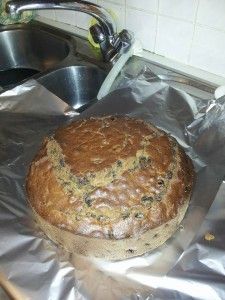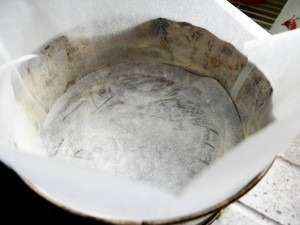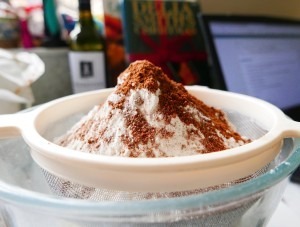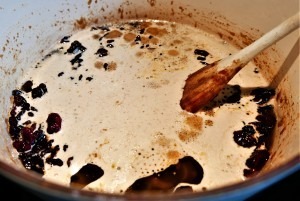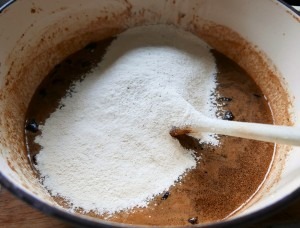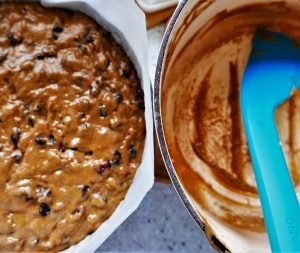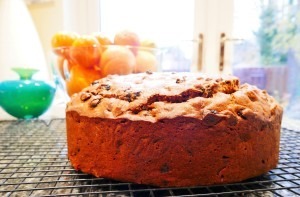
This is a recipe from my sister Mary, who inherited it from her Mother in law, Norah. They are both called Mrs. Hanly, so this is definitely their cake! Of course it’s a perfect cake for St Patrick’s day, and it will last all the way through Paddy’s week, as it now is!
Porter is an Irish word for a very dark ale, such as Guinness. However one day I went to make it, and had all the ingredients, except the Porter. I phoned Mary in a flap; she said just to use beer, so I used one of Mr Sat. Night’s expensive German beers, and it turned out beautifully. It’s always worth knowing that there’s an alternative!
This is a huge cake and keeps almost forever, wrapped in grease-proof paper and put into a tin with a close fitting lid. It is terrific for school lunches, as it is your original ‘cut-and-come-again’ cake.
I like it as one big – and it is BIG – cake, but Mary has previously made it in two loaf tins with reduced cooking time.
EDIT: To make ONE 2lb loaf-tin sized cake, use half of the ingredients below, but use 2 eggs, and gave it 50-55minutes at 140Fan. It still makes a very substantial cake..
As you can see from the photograph above, Mary wraps it up in tinfoil for keeping, and for travelling to grateful recipients!
EQUIPMENT:
- a 23cm circular cake tin, sides and base lined with baking parchment.
- Your largest saucepan – I use my cast iron casserole dish.
- a long-handled wooden spoon.
- A heat-proof board.
- 2 medium/large bowls.
- A sieve.
INGREDIENTS:
- 350g butter or margarine (I’m only putting the margarine in because it’s in the original recipe, but I use butter for this)
- 350g dark brown sugar
- 700g of sultanas, or fruit of your choice mixed – yes, this is a BIG cake!
- 300mls of Guinness
- 700g Self-raising flour
- 1 teaspoon of Baking Powder
- 1 tsp each of mixed spice and ground cinnamon
- 3 large eggs
METHOD:
- Line and butter the tin
- Heat the oven to 140 degrees fan; cooking time will be up to 2 hours.
- Sift the flour, baking powder and spices into a large bowl, and leave to one side.
- Weigh the fruit into another bowl, then weigh in the sugar on top of it.
- Put the butter into the saucepan, and allow it to melt on the hob on a medium heat.
- Add the sugar and the fruit, and stir until sugar has dissolved – this happens very quickly, but do check the back of your spoon to make sure there are no grains of sugar left.
- Add the Guinness
- Remove the pot from the heat, and put it onto a level, heatproof surface – I use a wooden board.
- Sift in the flour mixture in batches, folding in well before any new addition.
- Add the eggs one at a time, mixing well between each addition.
- Put the mixture into the prepared tin, it will look rather odd as it has a slightly strange consistency, but this is fine.
- Set the timer for 1 hour or so, then have a look. It won’t be done at this stage, but it’s a good time to turn the tin through 180 degrees, to allow it to bake evenly.
- Give it another half hour then start testing. Test every 15 minutes up to a final cooking time of about 2 hours. When the cake tester comes out dry, it’s done.
- If the cake starts to get too brown towards the end, cover it with a double sheet of brown paper with a hole cut in the top
- Beware: when Mary got a new oven, it took 15 minutes OFF the cooking time!
- Allow to cool in the tin for at least 1 hour. then remove to a cake rack.
- Allow to cool completely overnight, covered with a clean tea-towel. Don’t let the family nag you into cutting it before then, as it will be terribly crumbly and difficult to slice!
NOTES:
- This cake keeps really well – it appears to be the original Cut-and-Come-Again Cake. Mary used to put a buttered slice into the kids’ school lunchboxes – what a treat!
- I keep mine, wrapped in grease-proof paper, in a large tin, in a cool spot.
- Although it’s a lovely moist cake with a delicious flavour, and you can certainly eat it on it’s own, I do like a slice every now and then, with a generous spread of Irish butter!


